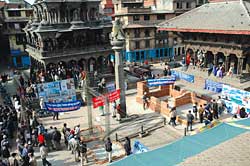 Some good comes out of even the most tragic events. Publicity of the havoc created by the Sumatra earthquake and the tsunami it unleashed in the Bay of Bengal last month has done more for earthquake awareness in Kathmandu than anything else in recent times.
Some good comes out of even the most tragic events. Publicity of the havoc created by the Sumatra earthquake and the tsunami it unleashed in the Bay of Bengal last month has done more for earthquake awareness in Kathmandu than anything else in recent times. That is why Mona Pradhan, 33, took her husband to Mangal Bajar this week to visit the Seventh Annual Earthquake Safety Exhibition. Mona was quizzing mason, Janak Maharjan, about the exact construction methods he used to make a life size demonstration earthquake-resistant model of brick walls and reinforced concrete beams.
"We are building a house and we wanted to make sure it can withstand earthquakes," she told us.
 Nepal Society for Earthquake Technology (NSET) which has been organising the annual exhibitions since 1998 to coincide with the great earthquake of 1934 which flattened Kathmandu Valley and killed more than 10,000 people. But this year, organisers say, there was unprecedented interest on new building techniques and disaster preparedness. Organisers lost count of the number of people who thronged the displays and stalls at Patan Darbar Square for three days this week.
Nepal Society for Earthquake Technology (NSET) which has been organising the annual exhibitions since 1998 to coincide with the great earthquake of 1934 which flattened Kathmandu Valley and killed more than 10,000 people. But this year, organisers say, there was unprecedented interest on new building techniques and disaster preparedness. Organisers lost count of the number of people who thronged the displays and stalls at Patan Darbar Square for three days this week. The theme this year for Earthquake Safety Day on 15 January was compliance to building codes. NSET's Mahesh Nakarmi explained: "It is possible to reduce fatalities from an earthquake if we make our buildings safer. You can't prevent earthquakes but you can be prepared for them." Nakarmi added that even if new houses in the Valley followed existing building codes they would be much safer.
But there are examples of new earthquake-resistant buildings which Nepali architects have pioneered and even taken the knowhow to Bam in Iran and to Afghanistan (see: 'A Bhaktapur bricklayer', #222) which would make housing safer. One of the exhibits, the 'Shake table', at Mangal Bajar this week was a platform with two models of apartment blocks: one retrofitted to withstand tremors and the other not. When the platform is shaken to simulate a strong quake, the unprotected house came down like a house of cards while the resistant design was unaffected. The watching crowd gasped in amazement.
Thirty other organisations participated in the exhibition, including the Royal Nepali Army, Everest Bank, ActionAid, United Mission Nepal and others. Many of the stalls belonged to community disaster-preparedness groups which displayed first aid kits, excavation equipment and other supplies needed for rescue in the aftermath of an earthquake. Many elderly Patan residents flocked to a photo exhibition of grainy black and white photographs of the 1934 earthquake and were seen pointing them out to their grandchildren.
Patan was an apt venue for this year's anniversary since it is the only town that has implemented an earthquake-resistant building code. It even has an earthquake safety section in the Lalitpur sub-metropolitan city office.
Although there was some grumbling from Patan's tourism entrepreneurs about converting the entire Darbar Square into an exhibition ground, NSET's Nakarmi justified it: "Just remember 1934, all these temples here had collapsed. If we don't prepare for the next earthquake there will be no heritage left to protect."


